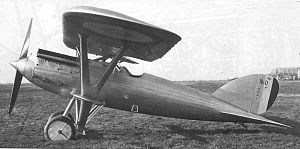Nieuport Ni-52
| NiD.52 & NiD.72 | |
|---|---|
 |
|
| A NiD 52 of the French Air Force | |
| Role | Fighter |
| National origin | France |
| Manufacturer | Nieuport-Delage |
| First flight | 1927 |
| Introduction | 1929 |
| Primary user | Spain |
| Number built | 135 |
| Developed from | Nieuport-Delage NiD 42 |
The Nieuport-Delage NiD 52 was a French fighter aircraft of the 1920s. A single-engined sesquiplane, it served with the Spanish Air Force, being operated by both sides of the Spanish Civil War.
In 1924 Nieuport produced a design for a single-seat sesquiplane fighter of mixed construction, the Nieuport-Delage NiD 42, which was ordered in small numbers for the French air force, entering service in 1927. Nieuport developed three refined versions in 1927, the all-metal NiD-52 and NiD-72 and the mixed construction Nieuport-Delage NiD 62. Like the NiD 42 on which it was based, the NiD 52 was powered by a Hispano-Suiza 12Hb V12 engine, but the wooden monocoque rear fuselage was replaced by an equivalent made of duralumin and the wooden wing ribs by light alloy, while retaining a fabric covering. Both the main and secondary wings were of reduced area compared to the NiD-42, and an enlarged tail fitted in an attempt to improve the aircraft's handling. Armament remained two 7.7 mm Vickers machine guns.
The prototype NiD 52 flew in late 1927, with the NiD 72, which was similar to the NiD 52 but had duralumin skinning on the wing and had a further reduced wing area, and the NiD 62 flying in January 1928. Although France preferred the cheaper NiD 62, purchasing it in large numbers, the NiD 52 won a competition for a new fighter for Spain in 1928, purchasing a licence for the construction of 125 aircraft to be built by Hispano-Suiza in their factory at Guadalajara. The similar NiD 72 was ordered in small numbers by Belgium and Brazil.
The Spanish Air Force started to take deliveries of NiD 52s in 1930, production continuing until 1933, equipping three fighter units, Grupo 11, Grupo 1 and Grupo 13. The "Hispano-Nieuport" (as it was known) was unpopular in Spanish service, being described as heavy and unresponsive, while it was slower than expected, with Spanish aircraft only able to reach 225 km/h (140 mph) compared with the 260 km/h (162 mph) claimed by Nieuport. Losses to accidents were heavy, with only 56 remaining when the Spanish Civil War broke out on 18 July 1936.
...
Wikipedia
